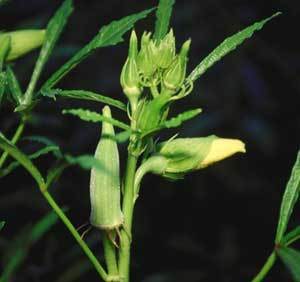
This page contains the following solutions.
If anyone is having problems getting okra seeds to grow, try soaking them in pure bleach overnight. The next day don't wash off the bleach and plant them as usual.
Here are the questions asked by community members. Read on to see the answers provided by the ThriftyFun community.
Every year I have my vegetable garden and I always plant Okra, which I love. When I get around the plant and start picking, I start itching like I have gotten into poison ivy. I use long rubber gloves for my hands and part of my arms, but my neck, face and the rest of my body itches so bad that I can't wait to take a shower and lotion down. Can anyone help me with this problem?
Sorry, I have this problem too. I wear long sleeves and rubber gloves (a real treat when it is 95 degrees). The more you can cover up the better. Then jump in the shower when you are done picking, if possible.
I hope someone else can offer a better solution than mine for you!
It seems like the itching would be caused by the little hairs all over the plants... Could you try hosing them down to wash off the loose hairs? The water might also keep the remaining hairs from coming off so easily and keep them from flying up in the air and landing on you while you pick. That, and using rubber work gloves might help. Good luck!
I would try to find someone to pick for me. Perhaps if you offered them some veggies in return? Then hose them down before bringing them in. Worth a try. Good luck.
I think I'd buy it at the farmers market!
This is very common with okra harvesting! The okra stings and makes my hands itch when preparing it for cooking. I love it, so I don't let it bother me too much.
I don't know about okra, but I discovered this summer that Virginia creeper does it to me. I Googled "poison ivy" and learned that Virginia creeper does affect some people this way. It's a vining plant that has 5 leaves instead of poison ivy's 3. Just sending this in as an informational warning to others!
Cantate
I have the same problem. I cover up as much as possible (as stated),then harvested with a very sharp knife in one hand while trying not to come in contact with the plant at all...letting the okra drop to the ground and gathering them up after I'd cut all I wanted. I didn't itch unless I touched the leaves...so wash up as soon as you get in the house and avoid touching your face before you wash.
Go to your local hardware shop and see if you can buy an extension pruner. It is on a long telescopic handle, with a gripper next to the blade so that what you cut does not fall down. Might take a bit of practice to get used to.
The best thing to do is to pick it when it is cool outside, like early in the morning.
I know this is old but with the water suggestion it makes it worse and it can easily burn the plant. The earlier the better and cover up.
I found some information about this as my husband started burning and hurting after picking okra. His even went one step further and started causing lesions on his nose and beside his mustache area on his face.
Thank you for the link to the study. Makes sense. Ill forgo growing okra in the futuretoo itchy and I hate that they tested it on Guinea pigs!!! Poor animals!!!
What is a good spacing between okra plants?
By Hugh
I believe it is about a foot on any side (to the one in front and back of the plant, and across to plant on each side, if any).
For three or four years we have had trouble getting okra to grow and produce. We don't know if it is our soil or the seed. This year we even bought new seed. Can anyone give us some pointers?
By Linda J
Check out these photos.
I think we have the tallest Okra in the South. My husband is picking it, because I am only 5 feet tall. I would need a ladder. And the stalks are like small trees!
This is a beautiful picture of a flower from my okra plant. To me the flowers are a blend of an orchid and magnolia blossom. I love the way I captured the morning dew. Who knew such a beautiful flower would come from a vegetable plant!
Flower Bed Okra is a strain of okra developed by a man in Texas, that grows like a shrub with many branches and gets over 5 feet tall. This seed variety doesn't appear to be mass produced.